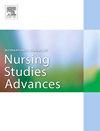Navigating family-witnessed resuscitation in hospitals: content analysis of free-text survey data
IF 3.1
Q1 NURSING
International Journal of Nursing Studies Advances
Pub Date : 2025-05-15
DOI:10.1016/j.ijnsa.2025.100347
引用次数: 0
Abstract
Background
Although international guidelines advocate family-witnessed resuscitation, its implementation varies considerably across countries. Clinical practice is often shaped by healthcare professionals’ personal beliefs and preferences, rather than standardised practice or evidence-based protocols. While patients and families generally support family presence for its reassurance and emotional closure, healthcare professionals express concerns about its potential to cause trauma. Previous researchers have primarily examined nurses' perspectives, with limited focus on physicians’ experiences. Moreover, most studies have been conducted in emergency and intensive care settings, leaving a gap in understanding collaborative perspectives across diverse clinical settings.
Objective
To describe nurses’ and physicians’ attitudes and experiences regarding family-witnessed resuscitation during adult cardiac arrest across various hospital departments and levels of care and to suggest key areas for targeted improvements and practical clinical applications.
Design
A qualitative design was applied to analyse free-text responses from a questionnaire distributed to healthcare professionals participating in an educational intervention.
Setting
Conducted in six Swedish hospitals, we included healthcare professionals from emergency care, internal medicine, cardiology, infectious diseases, and orthopaedic, thoracic, and abdominal surgery departments.
Participants
A total of 96 nurses and 48 physicians, with a mean age of 42 years and 15 years of working experience, participated, of which 51 % had prior experience with family-witnessed resuscitation.
Methods
A summative content analysis was conducted. Texts were repeatedly reviewed, condensed into keywords, coded, and grouped into sub-categories and categories, which were compared for similarities and differences. Keyword frequencies were calculated to summarise attitudes and experiences within each sub-category.
Results
Three categories and seven sub-categories emerged. Taking a stand or being indecisive reflected the tension between balancing patient and family wishes and healthcare professionals’ preferences, with indecisiveness more common in cases involving vulnerable family members. Working under pressure encompassed challenges related to operational constraints during family-witnessed resuscitation, such as limited room capacity, confidentiality risks, insufficient family support, and disruptive family behaviours that could impair focus. Helping or harming the family captured the dual perception that family presence could facilitate understanding of the resuscitation process and support grieving if the patient did not survive, while also posing a risk of trauma for family members.
Conclusions
Family-witnessed resuscitation presents significant ethical and practical challenges for healthcare professionals. Targeted training may be essential to prepare them for managing the cognitive, psychological, cultural, and familial complexities inherent in these situations. The development and implementation of clear, evidence-based local guidelines can support resuscitation teams in adopting a consistent, safe approach to family-witnessed resuscitation. Such initiatives can enhance healthcare practice by balancing patient and family needs with ethical and professional standards.
Study registration
Not registered.
在医院导航家庭见证复苏:自由文本调查数据的内容分析
虽然国际准则提倡家庭见证的复苏,但其实施在各国差别很大。临床实践往往是由医疗保健专业人员的个人信仰和偏好,而不是标准化的做法或循证协议。虽然患者和家属通常支持家人在场,以获得安慰和情感上的封闭,但医疗保健专业人员对其可能造成的创伤表示担忧。以前的研究人员主要研究护士的观点,对医生的经验关注有限。此外,大多数研究都是在急诊和重症监护环境中进行的,在理解不同临床环境的合作观点方面存在差距。目的描述不同医院科室和护理水平的护士和医生对成人心脏骤停期间家庭见证复苏的态度和经验,并建议有针对性的改进和实际临床应用的关键领域。设计:采用定性设计分析参与教育干预的卫生保健专业人员问卷的自由文本回复。研究在瑞典的六家医院进行,包括来自急诊、内科、心脏病学、传染病、骨科、胸外科和腹部外科的医疗保健专业人员。共有96名护士和48名医生参与,平均年龄42岁,工作经验15年,其中51%有家庭见证复苏的经验。方法进行总结性内容分析。文本被反复审查,浓缩成关键词,编码,并分组为子类别和类别,比较其异同。计算关键词频率以总结每个子类别中的态度和经验。结果出现了3大类和7个子类。表明立场或优柔寡断反映了在平衡患者和家属的愿望与医疗保健专业人员的偏好之间的紧张关系,优柔寡断在涉及弱势家庭成员的情况下更为常见。在压力下工作包括与家庭见证复苏期间的操作限制相关的挑战,例如房间容量有限、保密风险、家庭支持不足以及可能影响注意力的破坏性家庭行为。帮助或伤害家人抓住了双重观念,即家人的存在可以促进对复苏过程的理解,如果病人没有活下来,可以支持悲伤,同时也会给家庭成员带来创伤的风险。结论家庭目击复苏对医护人员提出了重大的伦理和实践挑战。有针对性的培训可能是必要的,以使他们准备好处理这些情况中固有的认知、心理、文化和家庭复杂性。制定和实施明确的、以证据为基础的地方指南可以支持复苏团队采用一致的、安全的方法进行家庭见证的复苏。这些举措可以通过平衡患者和家庭的需求与道德和专业标准来加强医疗保健实践。研究注册:未注册。
本文章由计算机程序翻译,如有差异,请以英文原文为准。
求助全文
约1分钟内获得全文
求助全文
来源期刊

International Journal of Nursing Studies Advances
Nursing-General Nursing
CiteScore
5.80
自引率
0.00%
发文量
45
审稿时长
81 days
 求助内容:
求助内容: 应助结果提醒方式:
应助结果提醒方式:


